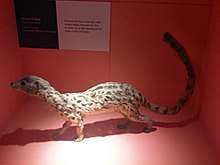African linsang
| African linsang | |
|---|---|
 | |
| Scientific classification | |
| Kingdom: | Animalia |
| Phylum: | Chordata |
| Class: | Mammalia |
| Order: | Carnivora |
| Suborder: | Feliformia |
| Family: | Viverridae |
| Genus: | Poiana |
| Species: | P. richardsonii[2] |
| Binomial name | |
| Poiana richardsonii[2] Thomson, 1842 | |
 | |
| African linsang range | |
The African linsang (Poiana richardsonii), also called Central African oyan, is a linsang species native to Central Africa.[1]
Distribution and habitat
The African linsang is endemic to Cameroon, the Central African Republic, the Democratic Republic of the Congo, Equatorial Guinea, Gabon, and the Republic of the Congo. It lives in lowland and montane forests.[1] The species is said to live at elevations of 950 m (3,120 ft) in the Democratic Republic of the Congo and at 300–500 m (980–1,640 ft) in north-eastern Gabon.[3]
Characteristics
Like all linsangs, African linsangs vary in colour, and resemble an elongated cat. They grow to a length of 33–43 cm (13–17 inches) for both sexes, excluding a banded tail that is almost as long as the body. They have slender bodies, relatively narrow heads, elongated muzzles, retractile claws, and dense, close fur.[4] They weigh only 500-700 grams (1–1.5 lbs).
African linsangs are white or cream in color on their ventral side, while the dorsal sides have dark circular marks. Sometimes an individual can have a black thin stripe that runs from the nose to the root of the tail. Its tail holds 10 to 14 rings which differ in measurement. The soles of the linsang's feet are covered with hair.[3]
Ecology
The African linsang is largely arboreal.[5]
It is an omnivore, eating insects and young birds as well as fruits, nuts, and other vegetation. It is thought that they could also take small vertebrates, but these are eaten only if the opportunity arises, as they do not hunt for them.[3] Although its breeding habits are largely unknown, it is thought that it gives birth to two or three young annually or semiannually.[6] When born, the young are altricial.
The African linsang is nocturnal, and generally lives alone or in a pair. They construct arboreal nests 2 meters above the ground with green materials. They only stay in a nest for a short amount of time before moving on to make a new nest. Very rarely, several linsangs will stay in the same nesting place. On average, linsangs in the wild live for about 5.3 years.
Species
There are two other species of linsang, the banded linsang (Prionodon linsang), and the spotted linsang (Prionodon pardicolor).[4] These species belong to the Prionodontidae family and are therefore more closely related to the Felidae than the Viverridae .[7]
Threats
The African linsang is possibly threatened by deforestation and bushmeat hunting.[1]
References
- 1 2 3 4 Gaubert, P. & Do Linh San, E. (2015). "Poiana richardsonii". The IUCN Red List of Threatened Species. IUCN. 2015: e.T41704A45219609. doi:10.2305/IUCN.UK.2015-4.RLTS.T41704A45219609.en. Retrieved 13 January 2018.
- 1 2 Wozencraft, W.C. (2005). "Order Carnivora". In Wilson, D.E.; Reeder, D.M. Mammal Species of the World: A Taxonomic and Geographic Reference (3rd ed.). Johns Hopkins University Press. pp. 532–628. ISBN 978-0-8018-8221-0. OCLC 62265494.
- 1 2 3 "African linsang - African linsang pictures and facts". TheWebsiteOfEverything. Retrieved 4 May 2014.
- 1 2 "linsang". Encyclopædia Britannica - Online Academic Edition. Retrieved 4 May 2014.
- ↑ Bahaa-el-din, L., Henschel, P., Aba’a, R., Abernethy, K., Bohm, T., Bout, N., Coad, L., Head, J., Inoue, E., Lahm, S., Lee, M. E., Maisels, F., Rabanal, L., Starkey, M., Taylor, G., Vanthomme, A., Nakashima, Y. and Hunter, L. (2013). Notes on the distribution and status of small carnivores in Gabon. Small Carnivore Conservation 48: 19–29.
- ↑ Whitfield, P., ed. (1984). Macmillan Illustrated Animal Encyclopedia. Macmillan Publishing Company. p. 92. ISBN 0-02-627680-1.
- ↑ Gaubert, P., & Veron, G. (2003). "Exhaustive sample set among Viverridae reveals the sister-group of felids: the linsangs as a case of extreme morphological convergence within Feliformia". Proceedings of the Royal Society, Series B, 270 270 (1532): 2523–30. doi:10.1098/rspb.2003.2521
